A softball lineup card is a document commonly used by coaches to organize and manage player positions and batting orders during a softball game clearly.
Also known as a softball lineup sheet, the layout adopts a simple format that any softball player or assistant coach can easily comprehend and implement. Depending on a coach’s preferences, the lineup card can be in the form of a digital file or physical document. The card is critical to effective player coordination and optimizing performance on the field.
The lineup of a softball team is based entirely on strategy, which may change from game to game, depending on the opponent team. Usually, a coach will research the opponents to understand their strengths and weaknesses, then develop effective strategies and a tactically sound lineup. This enhances the chances of success since a coach can maximize advantageous matches by exploiting the opponent’s defense.
The card visualizes players’ positions and the deployment of such strategies, as well as their effectiveness. It aids a coach in assigning specific defensive roles within the field, ensuring the team is well-structured. The coach then disseminates the lineup to all players and assistant coaches before the game. This helps minimize confusion and improves communication between players and the coach, enhancing teamwork and efficiency. The coach must also provide the lineup to game officials, such as those who introduce the players or maintain scores during the game.
This article will guide you on how to structure the card, valuable tips for completing it, and the various categories of lineup cards. We have also provided a wide collection of free printable templates in Excel format for your convenience.
Free Templates
Given below are softball lineup card templates:
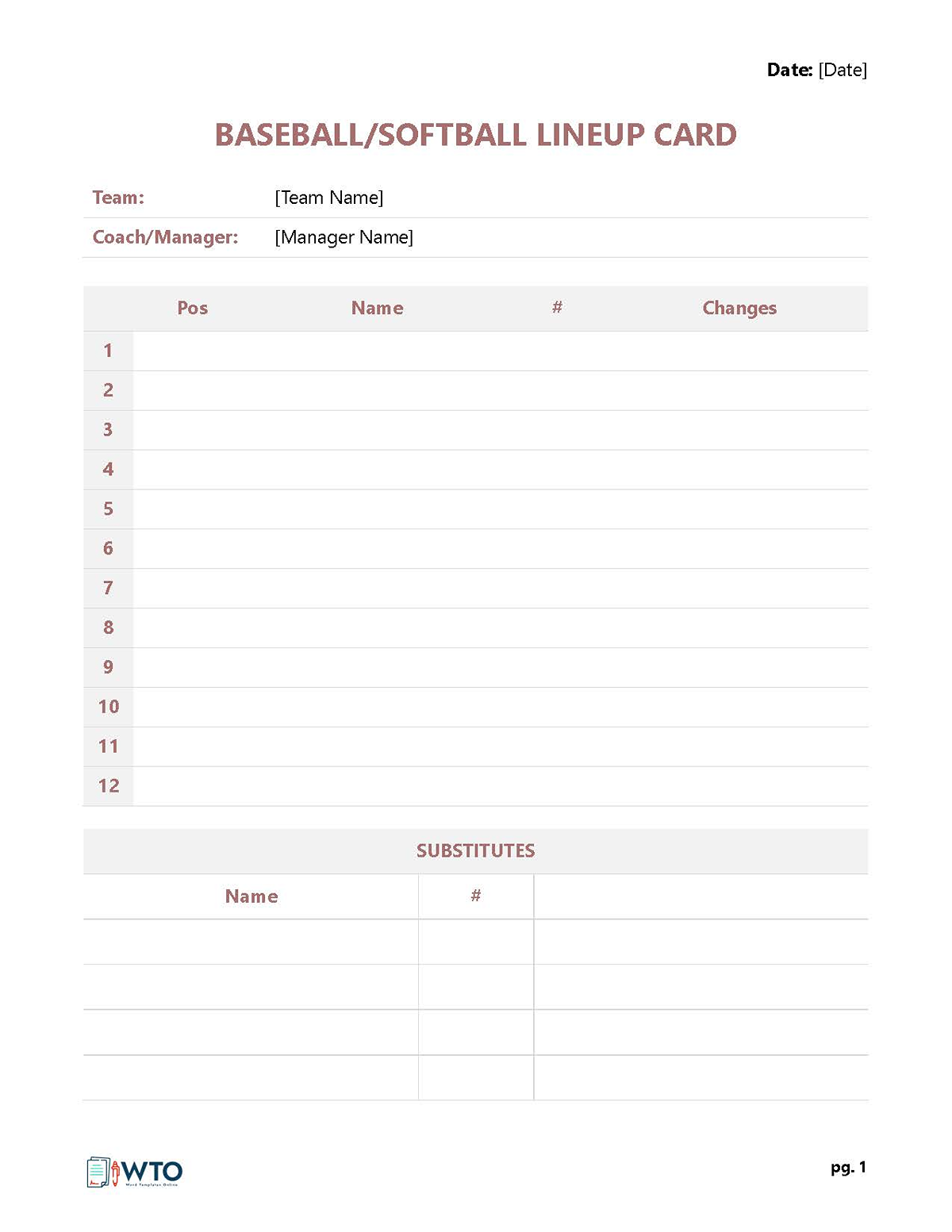

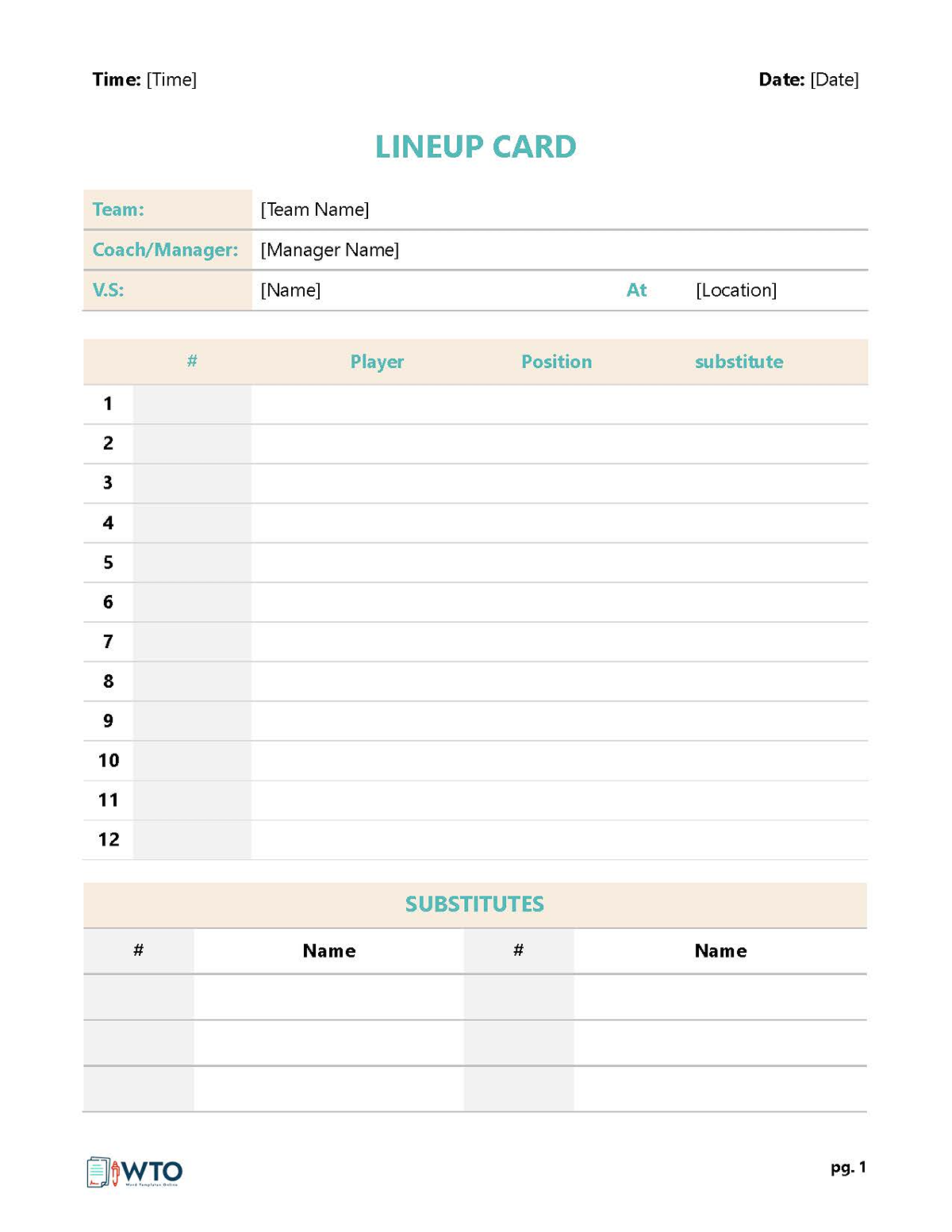
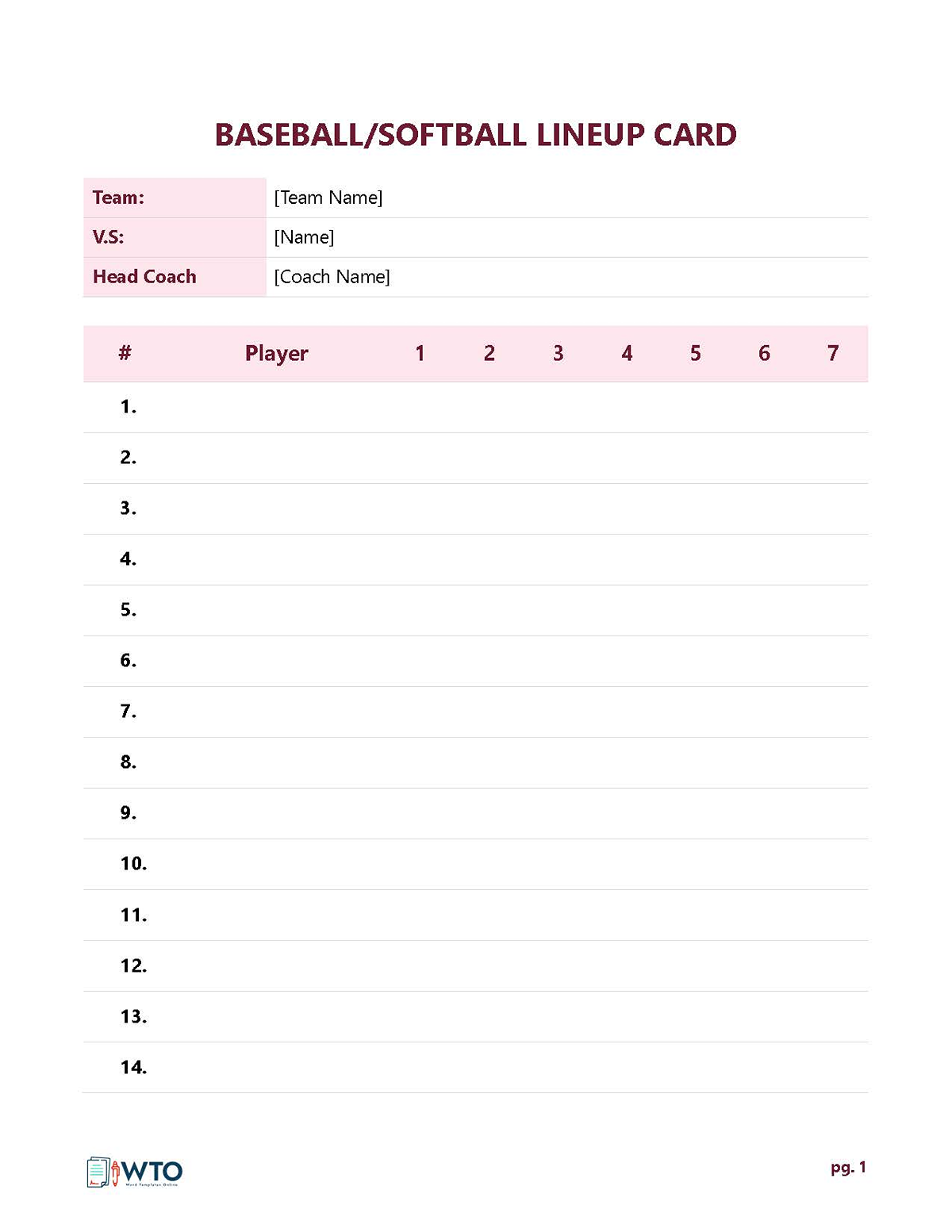
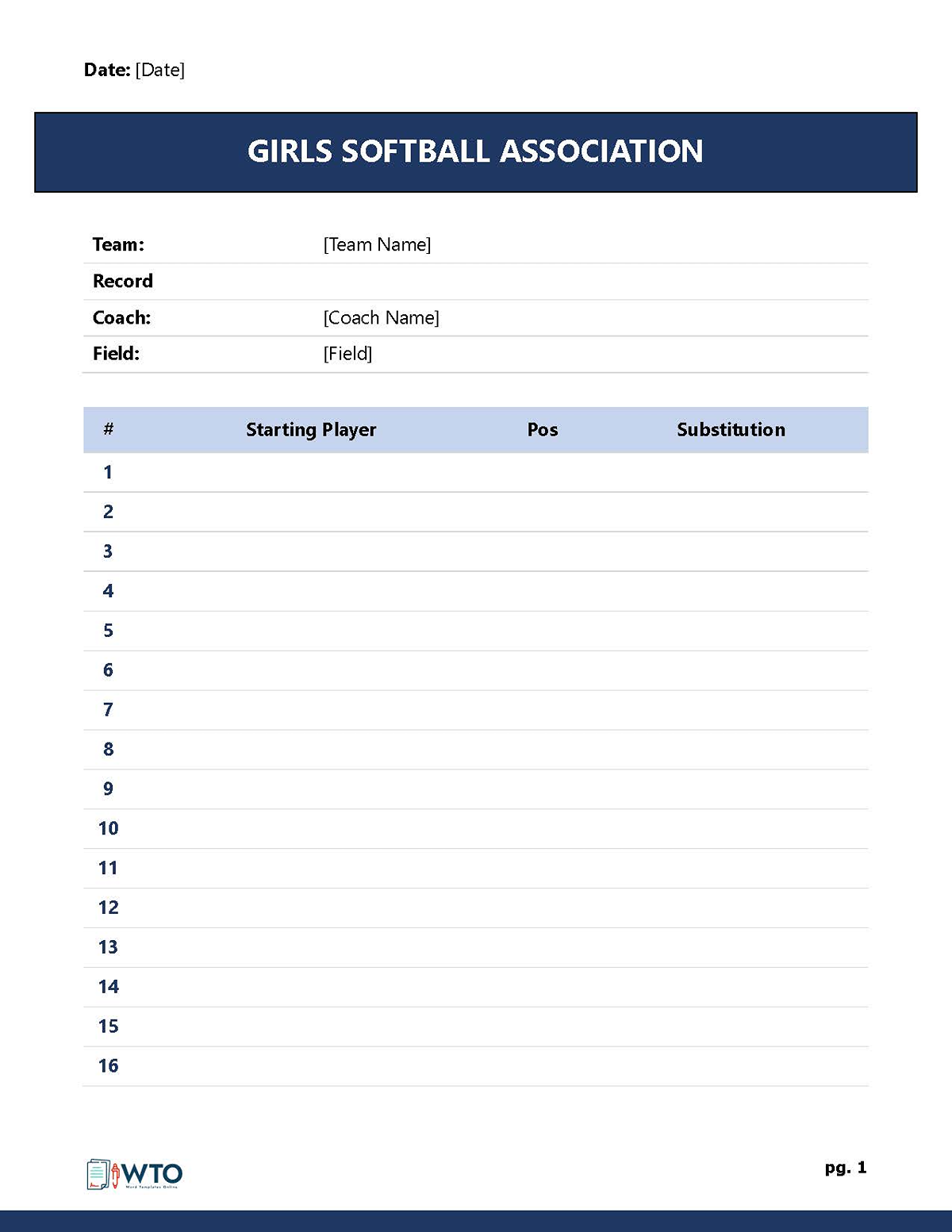
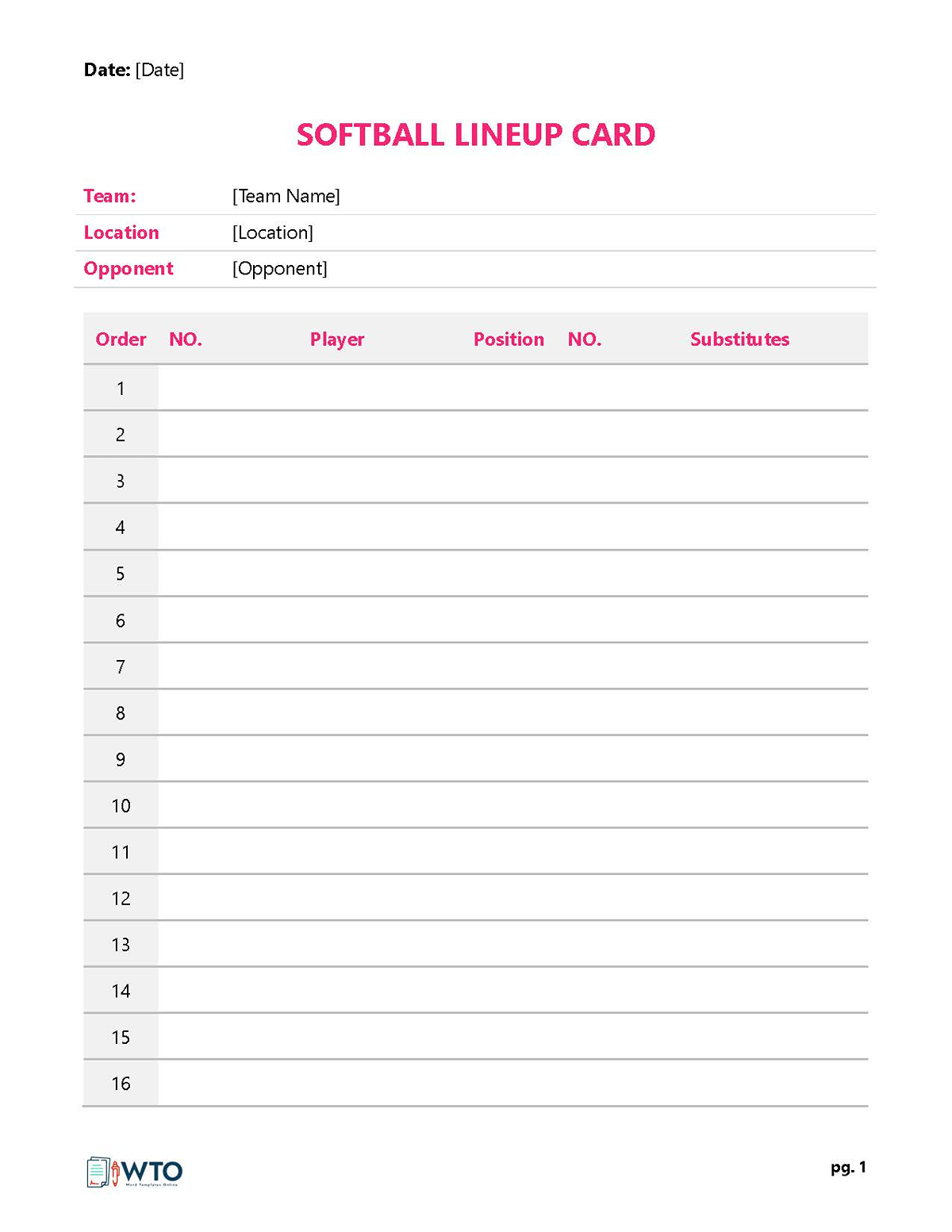
Components of a Softball Lineup Card
Typically, the card outlines the batting order and defensive positions for each player. However, to increase your chances of winning, there are other elements you should include on the card.
Below are the critical components of the card:
Header section
The top section of the card contains vital game information. The team name, logo, and slogan are included in this section, along with the opponent’s name, game location, and date of the game. The logo and slogan not only enhance the visual appeal of the card but also showcase the team’s identity and enhance recognition. Furthermore, including game information enhances clarity and gives additional context to the game the card pertains to.
Player’s information
The card has columns for capturing crucial details about each player. These include the player’s order, number, full name, jersey number, position, batting order, and names of substitutes. Clear identification of players aids in maintaining proper order and organization of the lineup. The batting order, on the other hand, specifies the sequence in which players will bat. Finally, the substitute name and number identify the player who will substitute a player if necessary.
Defensive position
This section identifies the players holding defensive positions on the field, primarily the pitcher and catcher. The catcher plays a vital role in defense since they receive the pitches, whereas the pitcher delivers the ball to the batter. Including these designations on the card helps ensure the best players are assigned crucial positions. This section may also include supplemental designations for other defensive positions, such as shortstop, outfield positions, and first, second, or third base.
Footer section
The card contains important information about the coaching staff in the footer section. These include the names of the head, associate head, and assistant coaches. The head coach is responsible for coordinating the game plan and making crucial decisions during the game. The associate head coach and assistant coaches are also essential members of the coaching staff whose contributions are critical to the team’s training and strategy. This section acknowledges and recognizes the guidance and support of the coaching staff and their contributions to the team’s success.
pro tip
Developing the lineup card from scratch using MS Excel can be time-consuming. A pre-formatted template provides a structured framework for creating the lineup card, ensuring uniformity and organization. Using a template allows you to devote more time to game preparation and strategic lineup decisions.
Tips for Completing a Softball Lineup Card
When it comes to creating a softball lineup, there are several variables to consider to increase your chances of winning. Most notably, the batting order and defensive positions can significantly impact the result of a match, and as such, these should be taken into account when completing the card.
Below are a few tips to consider when completing the card:
Communicate with your team
When completing the card, you must communicate your lineup with the players and coaching staff before the game. Make an effort to explain the lineup and your strategies to the players, ensuring they understand the batting order and assigned positions. Allow your players and coaching staff to convey their suggestions as well. Open dialogue promotes teamwork and encourages players to play at the highest level possible.
Stay organized
Keep the card accessible during the game by placing it in a cardholder. This not only allows you to reference the lineup quickly when making substitutions or adjustments but also protects the document from wear and tear. Additionally, you may print out a backup copy of the card and leave it with the assistant coach. Having a readily available copy of the card can be helpful in case of damage or loss to the original document.
Timely updates during the game
As the game evolves, modify and update the lineup card depending on defensive requirements, game progression, and batting opportunities. You may substitute a player, reassign defensive positions, or change the batting order. This helps optimize the team’s performance, ensuring accurate documentation and seamless substitution of players. It is important to have an organized system to capture changes made during the game, such as injury-related adjustments and substitutions.
Consider game situations and strategies
As a coach, it is crucial for you to be mindful of unique situations and strategies that may come into play as the game progresses. Scrutinize the strengths and weaknesses of the opposing team to develop a practical lineup. For example, if the opposing team started the game with strong hitters, you may place strong and fast power hitters in the middle or bottom of the lineup. These players should also be able to make drive-in runs with extra-base hits. Constantly fine-tuning the lineup as the game progresses gives your team a competitive edge and increases the team’s chances for victory.
Maintain accuracy and compliance
The players’ names, positions, jersey numbers, and batting order should be accurately captured on the card. Review the card for any errors or omissions before submitting it to the opposing team and umpire. To ensure compliance, check your league’s regulations governing lineup submission, as irregular or inaccurate information may result in fines or disputes during play. Double-check the card to ensure fairness and adherence to your league’s established regulations.
Categories of a Softball Lineup Card
Coaches may utilize one of several types of lineup cards, each with its unique purpose and features.
Below are the most common categories:
Slowpitch softball lineup card
In slowpitch softball, the pitch is delivered at a slower speed. Therefore, the lineup card reflects a more relaxed and recreational style of play. The defensive positions are varied, and the batting order adopts a more flexible approach. The card captures essential lineup information without specific designations for specialized positions. Slowpitch games are often social and are frequently played by co-ed teams or in informal leagues.
Fastpitch softball lineup card
Fastpitch softball is more competitive and fast-paced, with faster pitching speeds and a distinct set of regulations. It, therefore, requires a more competitive and strategic approach. Therefore, a fastpitch lineup card contains a carefully crafted batting order based on a player’s skills, offensive strategies, and situational awareness. Defensive positions, on the other hand, are assigned with specific designations for specialized catcher, pitcher, and infielder roles.
It may also include fields for additional information, including catcher and pitcher records. These help keep track of vital game statistics such as number of innings pitched, strikes, and balls. These additional elements aid in assessing player performance in order to make the proper adjustments.
Key Takeaways
- A softball match’s success relies on thorough preparation and efficient communication between a coach and players. A lineup card is proof of this, functioning as a vital tool that displays players’ positions and batting orders.
- The card captures essential information, such as players’ details, substitutes’ names, defensive positions, and coaches’ names. Each player’s name and position are carefully considered, resulting in a strategically sound lineup that echoes throughout the innings.
- Creating the card from scratch can be a time-consuming endeavor, especially if you have to devote time to devising winning strategies. Therefore, using a template to create the card can save time and effort.
- Printable templates are readily available in Excel format. Simply download one that best suits your needs and fill it out.
- As the umpire collects the lineup card and the first pitch is thrown, let your team’s manifestation of dedication and preparation be evident. Let each player’s strengths and contributions play meaningful roles in the pursuit of victory.




